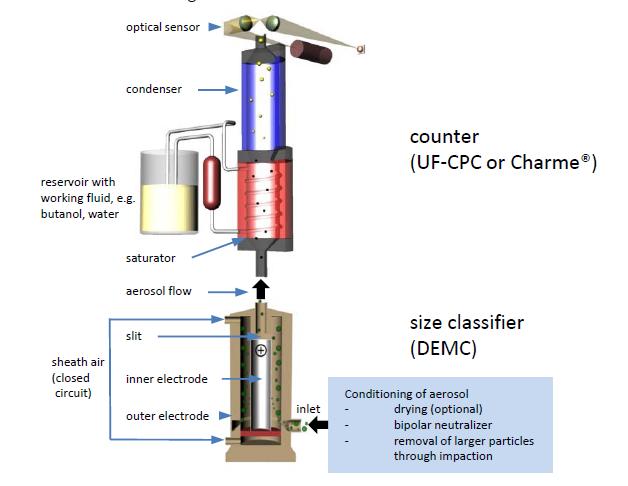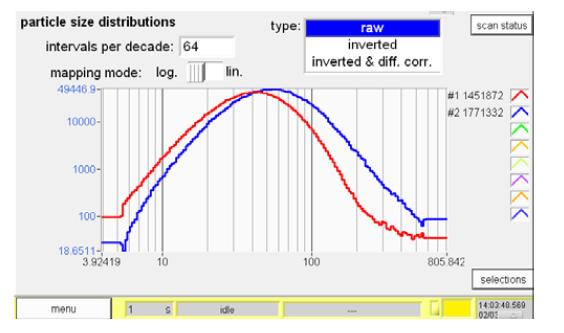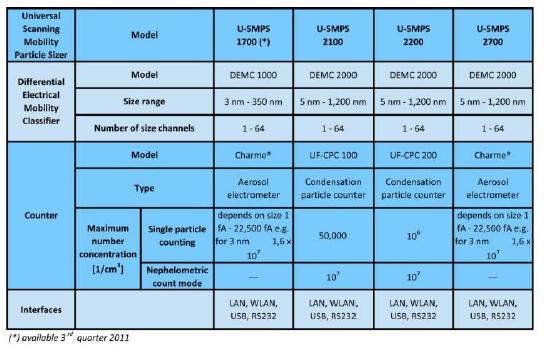The Palas® universal scanning mobility particle sizer – U‐SMPS continuously measures high‐resolution particle size distributions of submicrometer particles. It is commonly used when it is important to know the number concentration and size of ultra‐fine and nanoparticles, for example in health related research like inhalation and exposure studies or workplace evaluations. An increasing number of SMPS systems is also deployed in environmental monitoring stations.
The U‐SMPS consists of a size classifier, defined in ISO 15900 as differential electrical mobility classifier (DEMC), also known as differential mobility analyzer (DMA), in which the aerosol particles are selected according to their electrical mobility and passed to its exit. These particles are then counted by a condensation particle counter (e.g. Palas® UF‐CPC) or an aerosol electrometer (e.g. Palas® Charme®). A well‐known and optimized algorithm inverts the measured data to yield the particle size distribution. For the Palas® U‐SMPS Prof. Wiedensohler from IfT (Leipzig) has supplied the algorithm for the SMPS data inversion.
Based on the user settings a scan of the particle size distribution can be performed in as few as 30 seconds or in as many as 64 size channels per decade. The voltage in the DEMC is thereby varied continuously, not in steps, which results in higher count statistics per size channel.
Especially for calibration setups accurate sizing and reliable performance of the U‐SMPS is extremely important. All components have to pass a strict quality assurance test and are
assembled in‐house.
The U‐SMPS is operated through a graphical user interface on a large touchscreen. It offers linear and logarithmic display of measurement values and data management of the integrated datalogger. The evaluation software provides sophisticated data evaluation (extensive statistics and averaging) and export possibilities.
The U‐SMPS is typically operated stand‐alone but can be connected to a computer or network by several interfaces (USB, WLAN, Ethernet, RS232/485).
The Palas® U‐SMPS universally connects to DMAs, CPCs and aerosol electrometers of other manufacturers.
Particular advantages:
• Aerosol particle size distributions from 3 nm to 1.2 μm
• Continuous and fast‐scanning operation principle
• High resolution of up to 64 size channels/decade
• Can be used for concentrations up to 108 particles/cm3
• Universally connects to DMAs and nanoparticle counters from other manufacturers*
• Graphical display of measurement values
• Intuitive operation via 7' touchscreen and GUI
• Integrated datalogger
• Supports multiple interfaces and remote operation
• Low maintenance
• Reliable function
• Reduces your operating expenses
Application examples:
• Filter testing
• Aerosol research
• Environmental & climatic studies
• Inhalation & exposure studies
• Indoor & workplace air quality measurements
Technical parameters:
DEMC:
• Particle size range: DEMC 1000 dp = 3 nm – 350 nm
DEMC 2000 dp = 8 nm – 1,200 nm
• Number of size channels: 1 – 64 / per decade
• Concentration range: up to 108 particles/cm3
• Flow sample / sheath air: 0 – 4 l/min / 0 – 16 l/min
• Operation terminal: Touch display 800 x 480 pixels
1.6 GHz Intel AtomTM Processor
2 GB Compact Flash
• Interfaces: USB, WLAN, Ethernet, RS‐232/485
• Power supply: 115/230 V; 50/60 Hz
• Dimensions control unit: 33 x 38 x 24 cm (H x W x D)
• Dimensions column: 15 x 57 cm (ø at base x H)
• Weight control unit: 12.9 kg
• Weight column: 9.3 kg
UF‐CPC:
• Particle size range: dp = 5 nm – 10,000 nm
• Concentration range:
UF‐CPC 100 CNmax ≤ 50,000 P/cm3 (single counting)
CNmax < 107 P/cm3 (nephelometric mode)
UF‐CPC 200 CNmax ≤ 1,000,000 P/cm3 (single counting)
CNmax < 107 P/cm3 (nephelometric mode)
• Concentration accuracy: 5% (single counting),
10% (photometric mode)
• Working fluid: Butanol, isopropanol, water or other
• Aerosol flow rate: Adjustable 0.30 to 0.60 L/min
• Digital single signal
detection: 20 MHz Processor
256 Raw data channels
• Light source: High stability, long life LED
• Dimensions (HxWxD): 33 x 38 x 24 cm (13 x 15 x 9.5 in)
• Weight: 10 kg (22 lbs)
Accessories:
• Aerosol Neutralizer Kr‐85
• Transport case
Figure 1 shows a schematic of the working principle of the U‐SMPS. Before the aerosol enters the size classifier (DEMC column) it is conditioned. An optional dryer (e.g. silica gel, Nafion) removes moisture from the particles. A bipolar neutralizer (e.g. Kr‐85) is used to ensure a defined charge distribution of the aerosol. An impactor at the inlet of the DEMC is used to remove particles larger than the classifier size range.

Fig. 1: Working principle of the universal scanning mobility particle sizer (U‐SMPS)
Then the aerosol enters the DEMC column through the inlet. The aerosol flow along the outer electrode is then carefully combined with a sheath air flow. It is important to avoid any turbulence and ensure laminar flow. The surfaces of the electrodes need to be of extremely high quality in regards to smoothness and tolerances.
The sheath air is a dry particle free carrier gas (typically air) that is continuously circulated in a closed loop and of a higher volume than the aerosol. The ratio between sheath air volume to sample air volume defines the transfer function and therefore the resolution of the DEMC.
By applying a voltage, a radial symmetric electrical field between the inner and outer electrode is created. The inner electrode is kept at a positive potential and is outfitted with a small slit at the top end. By balancing the electrical force on each particle with its aerodynamic drag force in the electrical field negatively charged particles are diverted to the positive electrode. Based on their electrical mobility some particles will traverse the slit and be able to exit the DEMC.
In operation, the voltage and therefore the electrical field is continuously changed and at different times particles of different mobility are exiting the DEMC and are successively counted by a submicron particle counter like a condensation particle counter (e.g. Palas® UF‐CPC) or aerosol electrometer (e.g. Palas® Charme®).
The well‐proven software offers special advantages to combine the data (voltage, particle number, etc.) to produce a particle size distribution as shown in figure 2.

Fig. 2: Particle size distribution of the output of a Palas® DNP 3000 particle generator
User interface and software:
Based on continuous customer feedback the user interface and software is designed for intuitive operation and real‐time control and display of measurement data & parameters.
The user interface also provides data management with the integrated data logger, various export capabilities and network support. With the software the measured data can be displayed and evaluated with many options available.
Available systems:
Figure 3 shows the different combinations of DEMC and counters available from Palas®. In addition most DMAs, CPCs and aerosol electrometers of other manufacturers are supported for use as component of the U‐SMPS system.

Fig. 3: Overview of the Palas® U‐SMPS systems
Palas® is continuously setting standards in aerosol technology with more than 50 patents filed since 1983. Our innovations result in superior quality and durability of the products that lead to unique technical and economic advantages for our customers. This is why Palas® established itself as a market leader in aerosol generation, aerosol dilution, and aerosol particle measurement world‐wide.